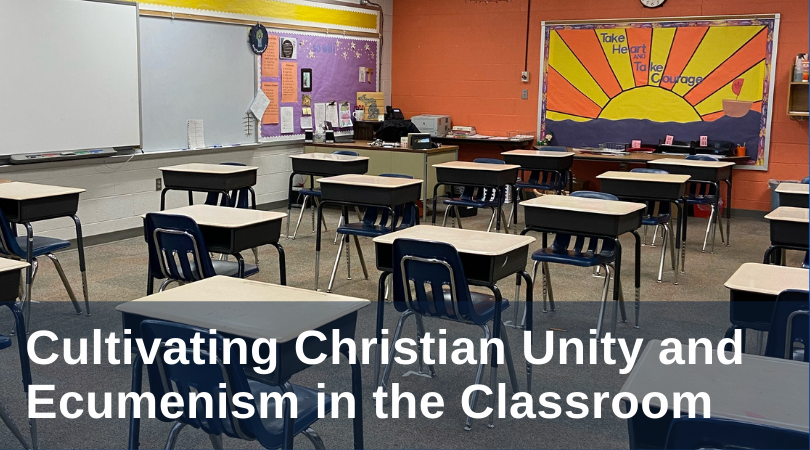
Teaching middle school religion in Tennessee at the local K–8 Catholic school, my classroom consists of students who are majority Christian, most of whom are Catholic, with a number of students who are Methodist, Baptist, and Episcopalian. Students with different religious backgrounds, even just within the Christian traditions, increase the ability and need for fruitful ecumenical dialogue and living within our classroom.
A few weeks into our study of the Church, my eighth-grade students encountered the vocabulary word ecumenism for the first time. After learning how to pronounce it properly, we broke down its meaning. Ecumenism refers to “the promotion of cooperation and unity among Christians” (USCCB, Ecumenical & Interreligious Affairs). In other words, ecumenism is the effort for Christians to come together in faith, as we are founded to be one Church by Jesus Christ, who offers all life and salvation.
Ecumenism is the responsibility of Christians, who are called to work and pray in hope for unity. During the Second Vatican Council, Pope St. John XXIII called for a focus on ecumenism. He saw that, in today’s world of division, Christians must come together through sharing prayer and knowledge, while upholding the diversity existing in the Church. Unitatis Redintegratio, the Council’s decree on ecumenism, calls for “the attainment of union” to be the concern of the whole Church—for the “faithful and shepherds alike” (§2).
As teachers, how can we foster ecumenical dialogue among students?
Root Education in Prayer
Beginning each class in prayer sets the focus beyond ourselves. Formation done in class occurs through the presence of the Holy Spirit. Call upon the Spirit to center, guide, and unite your class, and to foster faith in each student.
Set Guidelines for Class Conversations
Here are my middle school students’ guidelines for this year:
- Speak with respect for others, yourself, and the topic.
- Listen to what your classmates are sharing.
- Ask questions instead of making assumptions.
Keep your own classroom guidelines clear and visible for your students. To speak with respect, to listen, and to ask questions charges students to take responsibility for their learning. In order to have conversations with the whole class, it is the responsibility of each student to be respectful of his or her classmates. Reinforcing the guidelines throughout the year creates positive conversational habits for students, especially as they share perspectives on tough topics.
Invite Students to Share Their Faith
Inviting students to share about their faith traditions is key for ecumenical conversations, whether it be describing their denomination’s Advent traditions or articulating its teachings around the Eucharist. By inviting students to share, the conversation becomes fuller as students feel comfortable speaking up. Receiving students’ questions and experiences tells your students that their voice is welcome, their questions important, and their story irreplicable.
Share the Authority
Teachers are the authority in their classrooms, yet it is unlikely that a single teacher knows all the ins and outs of every faith tradition, especially the lived day-to-day. Creating the space for students to engage in dialogue with one another means sharing your authority—just a little. Allow your student to share their experience of a weekend service, how the sacraments are celebrated, or the denomination’s history. Being young in faith does not make one unknowledgeable in faith. As religious educators, we must encourage students to take ownership of their faith and prayer. Affirm your students’ sharing by asking them questions and thanking them for their input in class. Use this opportunity to learn with your students.
Remember that students are the expert of their experiences, but not necessarily of their denomination. When necessary, make clarifications about God and Church teachings, doing so gently so as to further learning, not shut down student voices.
Ecumenical living promotes the seeking of truth and the formation of community in prayer. If you are looking for examples of ecumenical living, look no further than a religion classroom in a modern Catholic school, which often includes students of Catholic and Christian denominations learning, praying, and sharing the faith together. Ecumenical conversations within the classroom are not as difficult as we imagine they might be; rather, they are written into the fabric of our schools. As religious educators, we have the unique opportunity to teach our students to engage in fruitful conversations, deepen their prayer lives, and care for one another, and to cultivate a classroom environment where we may all strive for holiness together.
Like what you read? Submit your email below to have our newest blogs delivered directly to your inbox each week.
Featured image courtesy of the author.


